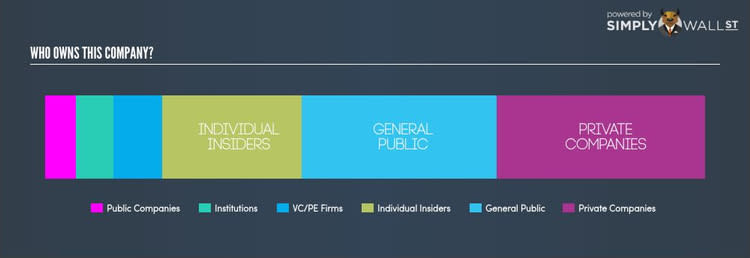What Does County International Limited’s (ASX:CCJ) Ownership Structure Look Like?

In this article, I will take a quick look at County International Limited’s (ASX:CCJ) recent ownership structure – an unconventional investing subject, but an important one. A company’s ownership structure is often linked to its share performance in both the long- and short-term. Since the same amount of capital coming from an activist institution and a passive mutual fund has different implications on corporate governance, it is a useful exercise to deconstruct XYZ’s shareholder registry. All data provided is as of the most recent financial year end.
Check out our latest analysis for County International
Institutional Ownership
Due to the big order sizes of institutional investors, a company’s shares can experience large, one-sided momentum, driven by high volume of shares removed from, or injected into, the market. A low institutional ownership of 5.67% puts CCJ on a list of companies that are not likely exposed to spikes in volatility resulting from institutional trading. Less covered stocks like CCJ used to feature in legendary investor Peter Lynch’s portfolio, which would later be bought up by fast-following institutions as the stock gained more popularity.
Insider Ownership
I find insiders are another important group of stakeholders, who are directly involved in making key decisions related to the use of capital. In essence, insider ownership is more about the alignment of shareholders’ interests with the management. One of the major owners in CCJ are individual insiders, sitting with a hefty 21.05% stake in the company. Broadly, insider ownership of this level has been found to negatively affect companies with consistently low PE ratio (underperforming). And a positive impact has been seen on companies with a high PE ratio (outperforming). Another aspect of insider ownership is to learn about their recent transactions. Insider buying may be a sign of upbeat future expectations, however, selling doesn’t necessarily mean the opposite as insiders may be motivated by their personal financial needs.
General Public Ownership
A big stake of 29.63% in CCJ is held by the general public. This size of ownership gives retail investors collective power in deciding on major policy decisions such as executive compensation, appointment of directors and acquisitions of businesses. Such level of ownership gives retail investors the power to sway key policy decisions such as board composition, executive compensation, and potential acquisitions. This is a positive sign for an investor who wants to be involved in key decision-making of the company.
Private Equity Ownership
With a stake of 7.43%, private equity firms form another important class of owners in CCJ. With a stake of 7.43%, they can influence CCJ’s key policy decisions. An investor should be encouraged by the ownership of these institutions who are known to be experts in increasing efficiency, improving capital structure and opting for value-accretive policy decisions.
Private Company Ownership
Potential investors in CCJ should also look at another important group of investors: private companies, with a stake of 31.44%, who are primarily invested because of strategic and capital gain interests. An ownership of this size indicates a strong financial backing and has the potential to influence CCJ’s business strategy. Thus, investors should dig deeper into CCJ’s business relations with these companies and how it can affect shareholder returns in the long-term.
What this means for you:
Are you a shareholder? Institutional ownership level and composition in CCJ is not high nor active enough to significantly impact its investment thesis. Looking for ways to reinforce your current portfolio holdings? Take a look at our free platform for a list of stocks with a strong growth potential.
Are you a potential investor? Ownership structure should not be the only focus of your research when constructing an investment thesis around CCJ. Instead, you should be evaluating fundamental factors like the relative valuation of CCJ, which is an important driver that determines CCJ’s share price. Take a look at our most recent infographic report on CCJ for a more in-depth analysis of these factors to help you make a more well-informed investment decision.
NB: Figures in this article are calculated using data from the last twelve months, which refer to the 12-month period ending on the last date of the month the financial statement is dated. This may not be consistent with full year annual report figures.
To help readers see pass the short term volatility of the financial market, we aim to bring you a long-term focused research analysis purely driven by fundamental data. Note that our analysis does not factor in the latest price sensitive company announcements.
The author is an independent contributor and at the time of publication had no position in the stocks mentioned.

